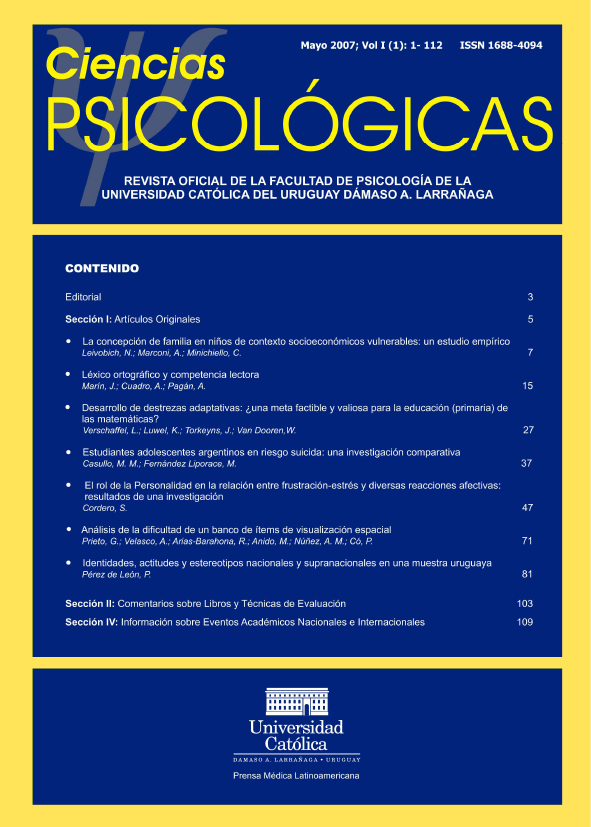DIFFICULTY ANALYSIS IN A SPATIAL VISUALIZATION ITEM BANK
DOI:
https://doi.org/10.22235/cp.v0i1.573Keywords:
Visualization, Item bank, Rasch model, Test ValidityAbstract
This work is the description of the validation process of a Visualization item bank, whose items were generated from a Surfaces Development task. The item bank was developed from Cognitive Design framework. The tests were applied to samples of first-year Engineering students. The item difficulty was estimated using the Rasch model. We observed that the item difficulty is associated to a task conditions involved in the ability of mentally transforming the objects and of maintaining active the spatial information during the transforming process.
Downloads
References
Baddeley, A. D. (1986). Working Memory. New York: Oxford University Press.
Bejar, I.I. (1993). A Generative Approach to Psychological and Educational Measurement. En N. Frederiksen, R.J. Mislevy e I.I. Bejar (Eds.), Test Theory for a new generation of tests. (pp. 323-358). Hillsdale, N.J.: LEA.
Bennett, G. K., Seashore, H. G. y Wesman, A. G. (1951). Counseling from profiles: A casebook for the Differential Aptitude Tests. New York: Psychological Corporation.
El Koussy, A. A. H. (1935). An investigation into the factors involving the visual perception of space. British Journal of Psychology, 20, 92.
Embretson, S.E. (1983). Construct validity: Construct representation versus nomothetic span. Psychological Bulletin, 93, 179-197.
Embretson, S. E. (1994). Applications of Cognitive Design Systems to Test Development. En C.R. Reynolds (Ed.). Cognitive Assessment: A Multidisciplinary Perspective. (pp. 107-135).
Embretson, S. E. (2005). Measuring Human Intelligence with Artificial Intelligence. En R. J. Sternberg y J. E. Pretz (Eds.) Cognition & Intelligence: Identifying the Mechanisms of the Mind. (pp. 251-267). New York: Cambridge University Press.
Embretson, S.E. y Reise, S.P. (2000) Item Response Theory for Psychologists. Mahwah, NJ: LEA.
Guilford, J. P. y Lacey, J. I. (1947). Printed Classification Tests, A. A. F. Aviation Psychological Progress Research Report, No. 5. Washington, DC: U. S. Government Printing Office.
Ghiselli, E. E. (1973). The validity of aptitude tests in
personnel selection. Personnel Psychology, 26,
-477.
Hegarty, M., Shah, P. Y Miyake, A. (2000). Constraints on using the dual-task methodology to specify the degree of central executive involvement in cognitive tasks. Memory and Cognition, 28, 411-430.
Hegarty, M. y Waller, D.A. (2005). Individual Differences in Spatial Abilities. En P. Shah y A. Miyake (Eds.). The Cambridge Handbook of Visuospatial Thinking. (pp. 121-169). New York: Cambridge University Press.
Hsi, S., Linn, M.C. e Bell, J.E. (1997). The role of Spatial Reasoning in Engineering and Design of Spatial Instruction. Journal of Engineering Education, 84, 151-158.
Irvine, S.H. y Kyllonen, P. (2002). Item generation for test development. Mahwah, NJ: LEA.
Kelly, T. L. (1928). Crossroads in the mind of man. Stanford: Stanford University Press.
Logie, R.H. (1995). Visuo-Spatial Working Memory. Hove: LEA.
Lohman, D.F. (2000). Complex Information Processing and Intelligence. Em R.J. Sternberg (Org.) Handbook of Intelligence. (pp. 285-340). Cambridge, UK: Cambridge University Press.
Miyake, A. y Shah, P. (Eds.) (1999). Models of working memory. Cambridge: Cambridge University Press.
Miyake, A., Rettinger, D. A., Friedman, N. P., Shah, P. Y Hegarty, M. (2001). Visuospatial working memory, executive functioning ans spatial abilities. How are they related? Journal of Experimental Psychology: General, 130, 621-640.
Muñiz, J. (1997). Introducción a la Teoría de Respuesta a los Ítems. Madrid: Pirámide.
Murdoch, J. R., Bainbridge, L. C., Fisher, S. G. y Webster, M. H. C. (1994). Can a simple test of visual motor skill predict the performance of microsurgeons? Journal of the Royal College of Surgeons, Edinburg, 39, 150-152.
Pellegrino, J.W. & Kail, R. (1982) Process Analyses of Spatial Aptitude. En R.J. Sternberg (Ed.), Advances in the psychology of human intelligence, 1. (pp. 311-365). Hillsdale, NJ: Lawrence Erlbaum Associates.
Peters, M., Chisholm, P. y Laeng, B. (1995). Spatial Ability, Student Gender, and Academic Performance. Journal of Engineering Education, 84, 69-73.
Prieto, G. y Delgado, A.R. (2002). Diseño cognitivo de un banco de ítems de visualización espacial. Metodología de las Ciencias del Comportamiento, volumen especial, 452-455.
Prieto, G. y Velasco, A. D. (2002a). Construção de um teste de visualização a partir da psicología cognitiva. Avaliação Psicologica,1, 39-47.
Prieto, G. e Velasco, A.D. (2002b). Predicting Academic Success of Engineering Students in Technical Drawing from Visualization Test Scores. Journal for Geometry and Graphics, 6, 99-109.
Prieto, G. y Velasco, A.D. (2003). Uso del modelo de Rasch para poner en la misma escala las puntuaciones de distintos tests. Actualidades en Psicología, 19, 7-24.
Prieto, G. y Velasco, A. D. (2004). Training Visualization Ability by Technical Drawing. Journal for Geometry and Graphics,8, 107-115.
Rasch, G. (1960). Probabilistic models for some intelligence and attainment tests.Copenhague: The Danish Institute for Educational Research.
Santisteban, C. y Alvarado, J.M. (2001). Modelos psicométricos. Madrid: UNED.
Tabachnick, B.G. y Fidell, L.S. (2007). Using multivariate statistics. Boston: Pearson.
Thurstone, L. L. (1938). Primary Mental Abilities. Chicago: University of Chicago Press.
Ting, S.R. (2001). Predicting Academic Success of First-Year Engineering Students from Standardized Test Scores and Psychosocial Variables. International Journal of Engineering Education, 17, 75-80.
Wright, B.D. y Linacre, J.M. (1998). WINSTEPS : A Rasch computer program. Chicago: MESA Press.
Downloads
Published
How to Cite
Issue
Section
License
Copyright (c) 2007 Universidad Católica del Uruguay

This work is licensed under a Creative Commons Attribution 4.0 International License.
















